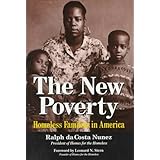Report by The Institute for Children, Poverty, and Homelessness, "Intergenerational Disparities Experienced by Homeless Black Families," highlighting disparities among black and white families in the United States, has gotten people talking about this topic.
Poverty and Homelessness History NYC TIMELINE
The New Poverty: Homeless Families in America
Synopsis
"The New Poverty: Homeless Families in America explores the complex issues surrounding the epidemic of homelessness and presents plausible solutions to reverse the spread of this scourge. The book clearly defines the extent of the issue - its scale, severity, and scope - and offers a viable alternative to stem homelessness, poverty, and welfare dependence in America. Dr. Nunez, esteemed for his work in social welfare policy, makes an important contribution to the current literature on homelessness by proposing a bold new direction for national homeless policy, one that calls for the transformation of the emergency shelter system into comprehensive residential-educational-employment training centers that are child focused and family based. Supported by compelling interviews and photographs of homeless families, the author logically contends that with education, family preservation services, and job training, these families can become self-sufficient. However, if they are deprived of these opportunities, another generation of children will grow up without homes and without the traditional values of work, responsibility, and independence. The New Poverty is intended to reach many audiences, from general readers to professionals in sociology, political science, education, public policy, and the legal and medical communities. In the midst of the current tense political climate, this extraordinary book will educate and enlighten the public on the history and realities of family homelessness, as well as give policy makers and academics substantive material to help make decisions and develop policy and program directives." Title Summary field provided by Blackwell North America, Inc. All Rights Reserved
Show less
The Poor Among Us: A History of Family Poverty and Homelessness in New York City
Description: Conditions that perpetuate homelessness and poverty today have deep roots in America's past. In The Poor Among Us, Ralph da Costa Nunez and Ethan G. Sribnick explore the world of New York's poor children and families, from the era of European settlements to the present day: their physical and social environments, the causes of their poverty, and the institutions and social movements that evolved to improve and regulate their lives. This comprehensive history examines the successes and failures of past efforts to reduce poverty and homelessness, providing the historical context that is often lacking in contemporary policy debates. More than 100 photographs, etchings, and maps bring the reader face-to-face with the realities of poverty and homelessness.
The face of American poverty is now a suburban one, according to new research from the Brookings Institution.
Researchers found that the number of people living in poverty in the suburbs soared 64% between 2000 and 2010, more than twice the rate of urban areas-meaning that now more poor people live in suburbs than in cities or rural areas, although the overall poverty rate remains higher in cities, the Miami Herald reports.
 |
| The Institute for Children, Poverty, and Homelessness |



No comments:
Post a Comment